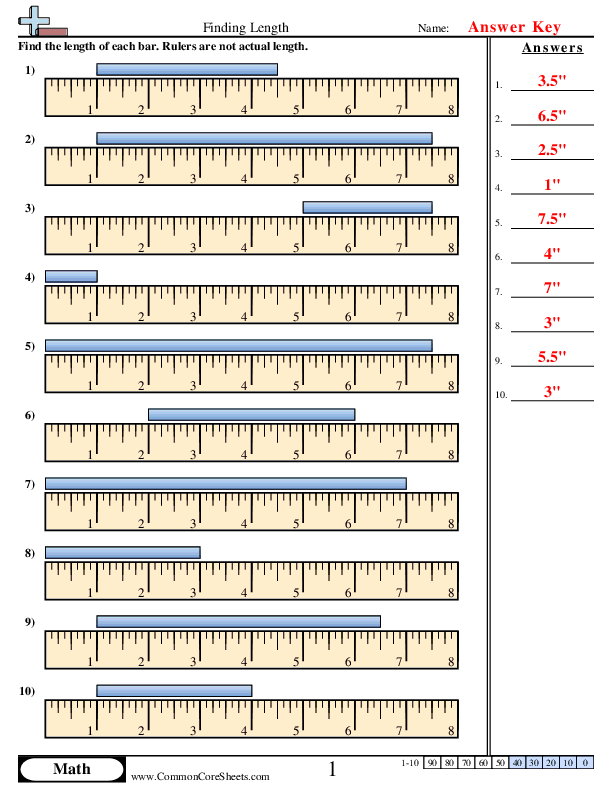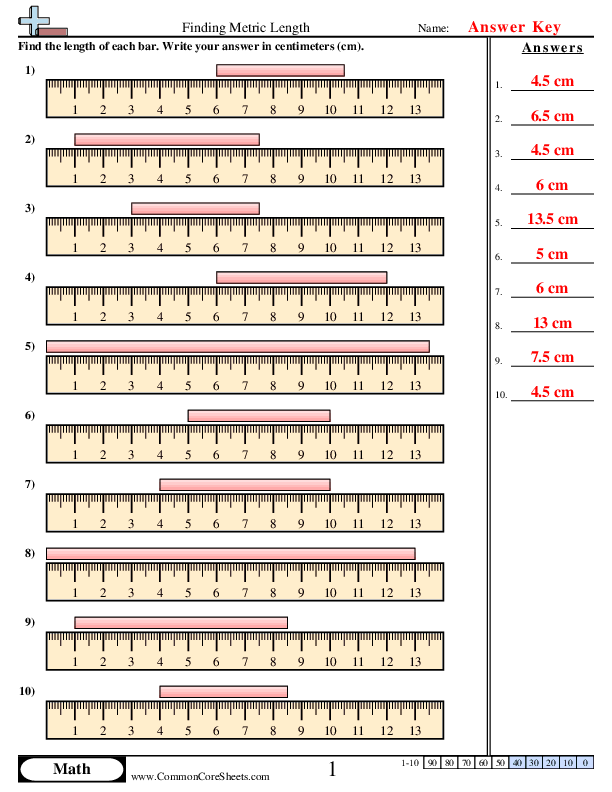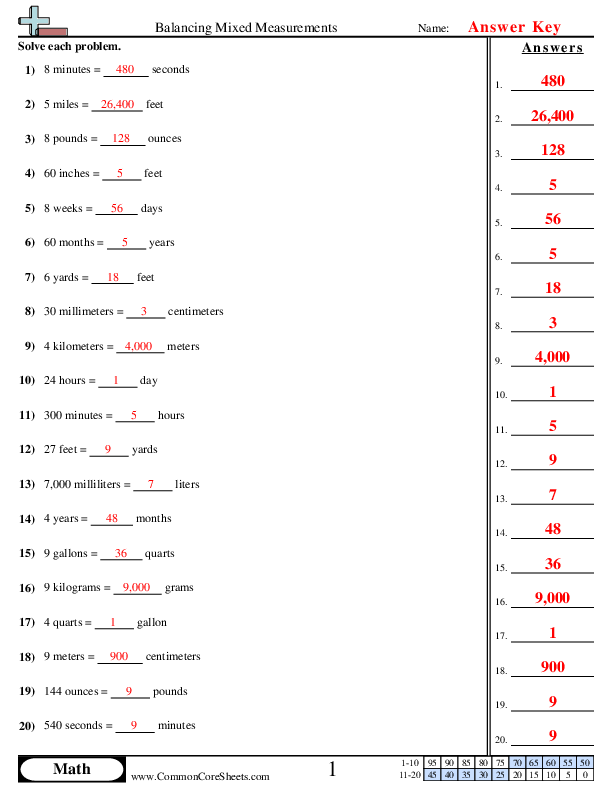Looking for the best measurement worksheets on the internet? Look no further! Our measurement worksheets are designed to help students of all ages learn and practice the important skill of measurement. From length and weight to volume and capacity, our worksheets cover a wide range of topics to ensure a well-rounded understanding of measurement concepts. And the best part? They're all free! Simply download and print as many copies as you need for your classroom or home use. These measurement worksheets are a great resource for teachers, students, and parents looking to improve their measurement skills. Try them out today and see the difference they can make in your understanding of measurement.
Browse Sheets By Problem Type
×
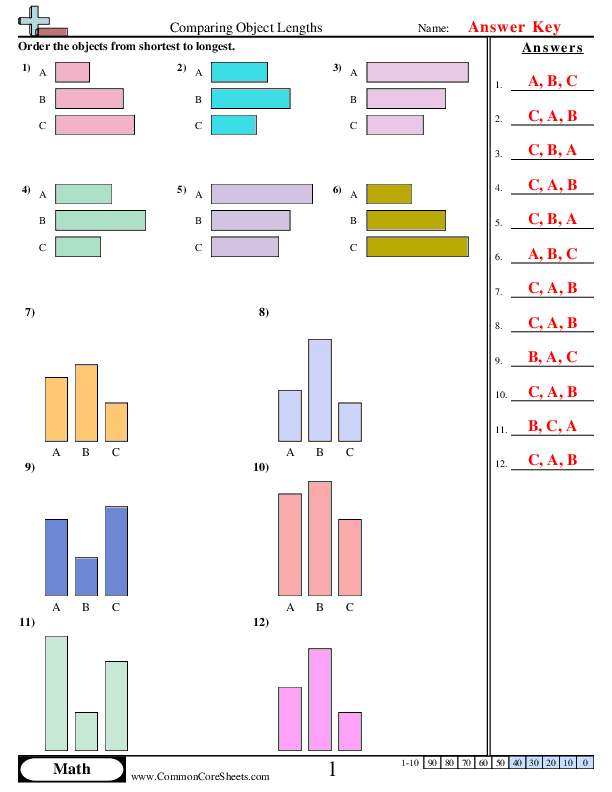
Comparing Object Lengths
1md1


×
Description:
"This worksheet is designed to teach kids the concept of comparing object lengths through math problems. With 10 customizable exercises, it encourages children to understand size differences visually and numerically. Easily convertible into flashcards, it's perfect for distance learning, giving young learners the freedom to study and explore these foundational math principles at their own pace."

×
Student Goals:
Mathematical UnderstandingStudents would gain a comprehensive understanding of how to compare object lengths. They would be able to differentiate between the lengths of different objects, even if the differences are minor. This mathematical skill helps develop their ability to analyze and compare data, which is a crucial part of numerical learning.Measurement SkillsIn the process of comparing lengths, students should be able to develop a fundamental understanding of measurements. This knowledge is vital in various real-world applications and within other areas of math, such as geometry. Using the principle of measurements, students will be able to estimate, approximate, and calculate actual lengths of various objects.Critical Thinking and Problem SolvingAccomplishing these tasks means students would have honed their critical thinking and problem-solving skills. They will learn how to approach a problem systematically and logically, varying their strategies depending on the scenario. By identifying which object is longer or shorter, they will learn to evaluate, justify, and communicate their mathematical thinking.Visual Spatial IntelligenceThis worksheet will aid students in enhancing their visual spatial intelligence. Comparing lengths requires visual perception skills and an understanding of spatial relationships between objects. This not only benefits students in mathematical tasks but also translates into improved navigation and organizational skills outside of the classroom.Application of Learned KnowledgeHaving completed the worksheet, students should be able to apply the knowledge and skills they've gleaned in practical everyday situations. Length comparison is a common task in daily life - from arranging books on a shelf to cooking measurements. By translating their academic understanding into real-world applications, students will appreciate the relevance and practicality of what they learn.


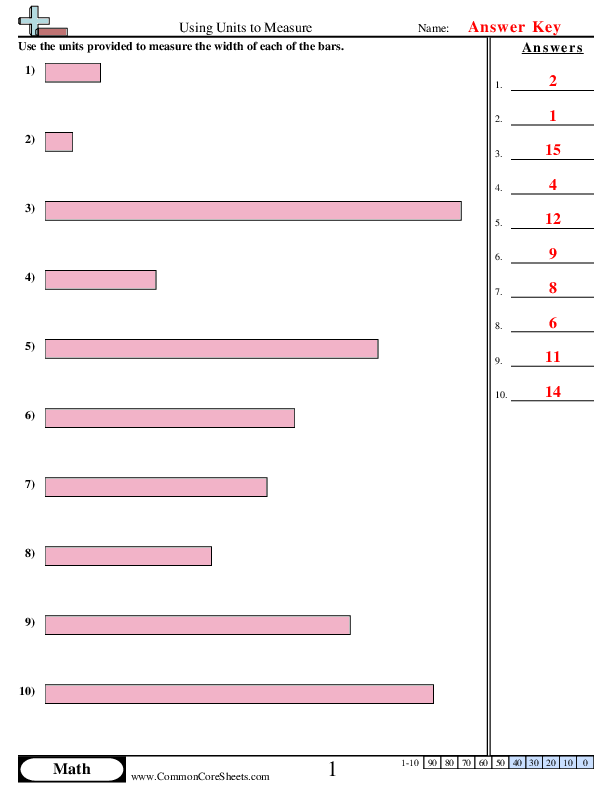
Using Units to Measure
1md2


×
Description:
"This worksheet is designed to enhance children's understanding of math, specifically in applying units to measure. It features ten unique problems that encourage practical learning. Adaptable for different learning styles, it can be customized to create flash cards or incorporated in distance learning modules. Its versatility provides a robust platform for mastering measurement units, thus laying a solid foundation in key math skills."

×
Student Goals:
Understanding of Measurement UnitsAfter completing the worksheet, students should have a deep comprehension of the basic units of measurements. They should be able to understand the concept and importance of units in measurement within the mathematical array. Their knowledge regarding the fundamentality of measurement standards across various situations would be deepened.Practical ApplicationsStudents should be capable of applying their newfound knowledge in real-life situations. The use of units of measurement isn't limited to the classroom; it's a fundamental skill needed for many daily tasks. Thus, these exercises would furnish them with a practical tool, aiding them in their day-to-day life, enhancing their problem-solving capacities.Accuracy in ConversionStudents should be adept in converting from one unit to another without any errors. They would gain proficiency in conversions, which is a vital skill for advanced mathematics and science. They should be able to convert units within the same system and even between different systems of measurement.Proficiency in Math ProblemsThe completion of this worksheet should also result in the overall improvement of students' math skills. The exercises in the worksheet are designed to practice their calculation skills, increase their competency in addressing mathematical problems, and foster a love for math.Enhanced Cognitive SkillsSolving problems pertaining to units of measurements fuels cognitive development in children. Students should demonstrate an improvement in cognitive skills such as concentration, logical reasoning, decision making, and critical thinking.Confidence BoostSuccessfully accomplishing the worksheet aids in boosting the student's confidence and self-esteem. The sense of achievement they receive after solving the problems correctly motivates them to face challenging tasks with more confidence, thereby promoting a positive approach towards learning.Preparation for Advanced StudiesLastly, this worksheet would serve as a stepping stone for students gearing towards more advanced studies. The understanding of units of measurements and the ability to convert between these units is required in higher-level studies in fields such as Physics, Engineering, and Architecture, making this worksheet a valuable learning resource.


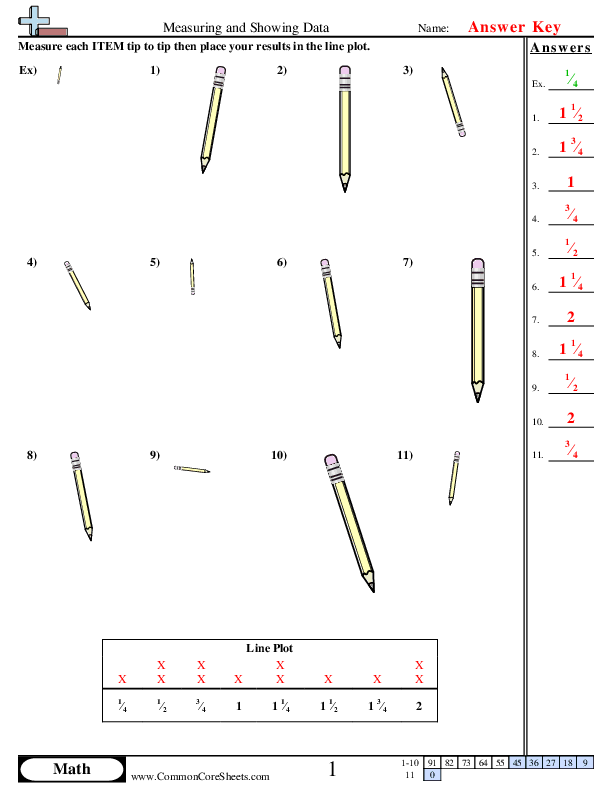
Measuring and Showing Data
3md4


×
Description:
"This worksheet is designed to empower children's understanding of math, specifically in the area of data measurement. Containing 11 stimulating math problems, it provides engaging challenges on displaying and interpreting data. The worksheet enables customization, and can be converted into flashcards for more interactive learning. It's also an ideal resource for distance learning endeavours to ensure continuous learning despite being away from a traditional classroom setup."

×
Student Goals:
Data Interpretation SkillsUpon completion of the worksheet, students should have developed advanced data interpretation skills. They will be proficient in understanding various data forms, including graphs, tables, and charts. Their comprehension of the underlying statistical concepts should enhance, enabling them to critically analyze presented data.Measurement UnderstandingStudents will gain an understanding of how to execute precise measurements and accurately record data. Grasping fundamental principles of measurements, students will be able to identify appropriate units and tools for measurement in practical situations.Problem-Solving AbilitiesThe worksheet is designed to sharpen students' problem-solving abilities. By tackling various problems, they will be well-positioned to develop systematic approaches to breaking down complex issues and devise effective solutions.Data Representation TechniquesAfter completing the worksheet, students should excel in data representation. They will be capable of using various methods to visually present data. Such skills are vital in communicating information in a succinct, understandable manner.Improved Mathematical LiteracyThe comprehensive structure of the worksheet will ensure an improvement in students' mathematical literacy. By becoming versed in data measurement and representation, they will broaden their understanding of mathematical concepts and language.Enhanced Critical ThinkingCompleting the worksheet will hone students' critical thinking skills. The ability to make logical connections between different pieces of information will be enhanced. This invaluable skill will prove useful across other academic subjects and in daily life situations.Quantitative ReasoningStudents will develop quantitative reasoning skills, enabling them to interpret numerical data accurately, draw appropriate conclusions, and make forecasts. They will gain knowledge about the importance and practices of accurate data prediction in decision-making processes.


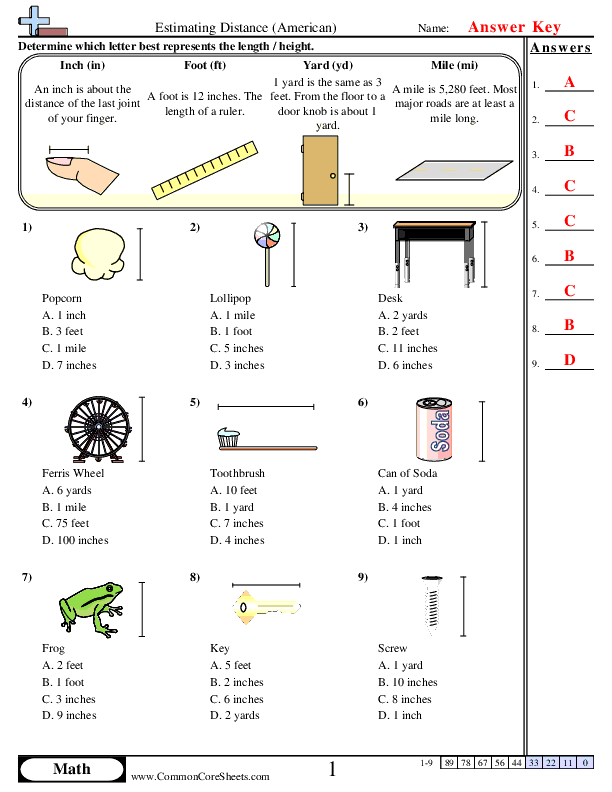
Estimating Length (American)
4md1


×
Description:
"This worksheet is designed to improve children's estimation of distances in a fun and interactive manner. Covering a wide range of objects, from skateboards to frogs, the activities engage learners through nine diverse math problems. Customizable to different learning needs, this worksheet can be converted into flash cards or suitably adapted for distance learning, ensuring flexibility in teaching methods while solidifying essential mathematical concepts."

×
Student Goals:
Understanding of MeasurementsUpon completion of the 'Estimating Distance' worksheet, students should have a developed understanding of the various units of measurement used in the American system. These include inches, feet, yards, and miles, and students will become familiar with their relative lengths and everyday uses.Estimation SkillsThe worksheet is designed to improve the practical estimation skills of students. Faced with objects and distances of various sizes, students should learn how to make quick yet accurate approximate evaluations of distances and sizes using known benchmarks. Thus, sharpening their mental estimation skills.Real-World ApplicationsAfter completing this worksheet, learners should have a clearer understanding of how these units of measurement are applied in real-world contexts. By relating commonly known objects in their estimation exercises, students gain insights into real-world applications of measurements.Critical ThinkingStudents will also enhance their critical thinking skills through the course of completing the worksheet. With every problem, students are required to consider the size and scale of the objects and distances involved, and to select the most appropriate unit of measurement. This encourages concept analysis and strategic thinking.Confidence BuildingFinally, successfully completing the worksheet should boost the students' confidence in their mathematical abilities. Not only will they have a stronger grasp of American measurement units, but they will also have refined their estimation and reasoning abilities. This increased confidence can inspire a more positive attitude towards learning math and related subjects.


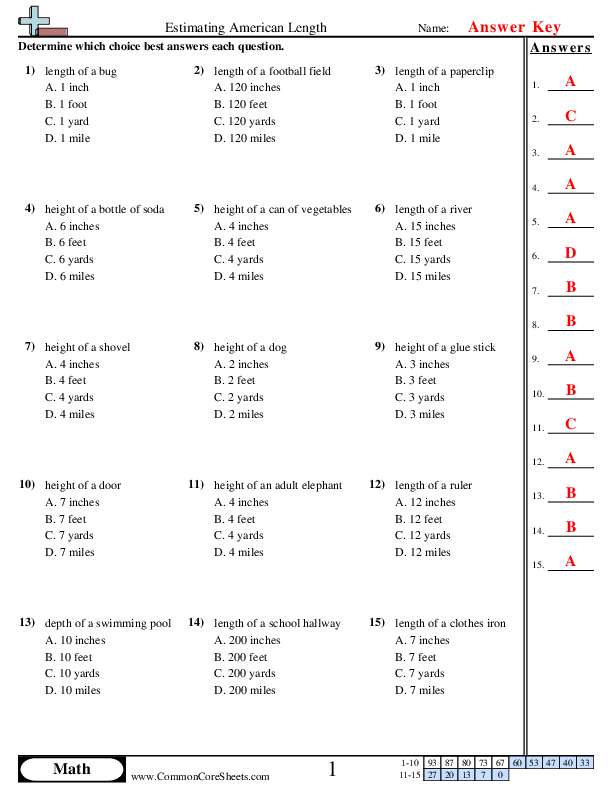
Determining Appropriate Measurement (American)
4md1


×
Description:
"This worksheet is designed to teach math through the concept of estimating American lengths. From social objects to natural wonders, the tasks encourage children to familiarize themselves with measurements like inches, feet, yards, and miles. It features 15 problems and can be easily customized, converted into flashcards, or used for distance learning, making it versatile for various teaching methods and environments."

×
Student Goals:
Measurement UnderstandingUpon successful completion of this worksheet, students will develop a solid understanding of the American length measurement units including inches, feet, yards, and miles, and the relative differences between them. They will gain insight into making educated estimations on the lengths and heights of everyday objects and elements of the natural world.Estimation SkillsStudents will develop valuable estimation skills which are critical not only in the subject of math, but throughout various aspects of life. They will become comfortable with making an educated guess or estimate, which can be a valuable problem-solving tool when precise information is unavailable.Real-World ApplicationsThe completion of this worksheet will enable students to apply their learning into real-world contexts. By relating the problems to everyday items like a can of soda or a skateboard, they will be able to visualize and grasp the concept of length estimation better. This understanding will transfer to their ability to approximate and compare distances in real-life situations.Critical ThinkingThis worksheet fosters critical thinking by encouraging students to use their knowledge of measurement units to evaluate and choose the most reasonable answer out of multiple choices. This skill of critically evaluating multiple potential solutions will benefit them in future mathematical problems as well as in wider life situations.Builds ConfidenceBy systematically developing an understanding and honing their estimation skills, students will gain confidence in handling problems related to length measurement. They will become capable of making quick estimations in their head and develop a sense of achievement in their mathematical abilities.Promotes Active LearningFinally, since the learning is couched within the framework of practical, real-life objects and situations, students are motivated to actively engage with the content. This active involvement in their own learning process can lead to a deeper understanding of the subject and improved academic performance in the long run.


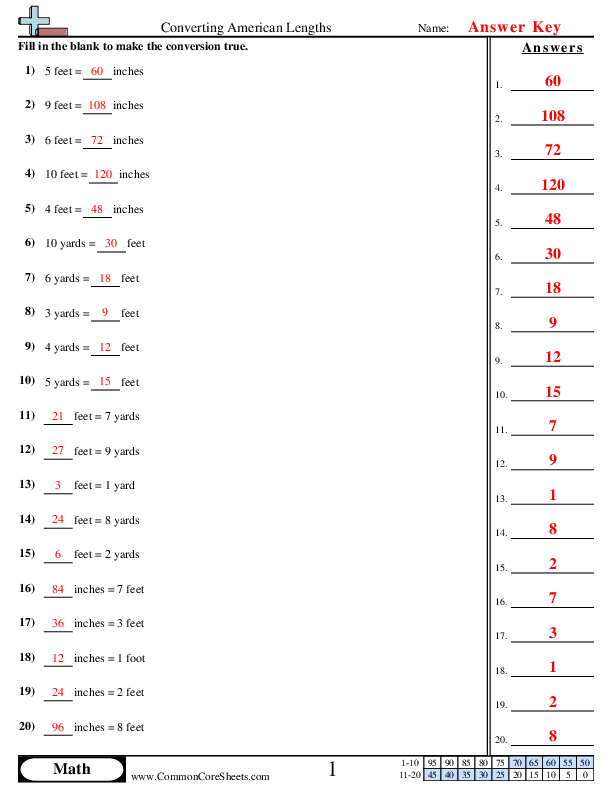
Converting American Lengths
5md1


×
Description:
"This worksheet is designed to aid children in converting American lengths for math learning. It features 20 problems, including conversion of feet to inches, yards to feet, fostering practical calculation skills. Ideal for distance learning, it can be customized to fit individual needs, or converted into flashcards for an interactive experience."

×
Student Goals:
Measurement Conversion UnderstandingAfter successful completion of this worksheet, students will have a clear understanding of how to convert American length units. They will be perfectly equipped to effortlessly interchange between feet, inches, and yards, fundamental building blocks of the American measurement system.Problem Solving SkillsThe variety of problems presented in the worksheet will help students to enhance their problem-solving skills. They will be better at tackling conversion problems, irrespective of the units of length involved, thus strengthening their capability to resolve real-world mathematical problems.Application of Mathematical KnowledgeThis worksheet will enable students to apply their theoretical knowledge of the American measurement system into practical examples. They will be adept at using their mathematical knowledge in everyday situations, be it understanding their height, or estimating the length of objects.Mental Math AgilityPractice makes perfect. Completing this worksheet will improve the student’s mental math agility. The continuous practice of conversion formulas not only fosters their memory recall but also accelerates their mental math speed, an essential skill for further mathematical learning.Boost ConfidenceAs students progress through the worksheet and start getting the correct answers, they will develop confidence in their mathematical abilities. This boost in self-esteem can encourage them to take on more complex mathematical challenges in the future.Foundation for Advanced LearningMastering unit conversion is a foundational requirement for advanced mathematical concepts and scientific calculations, in physics and engineering for example. Hence, successfully completing this worksheet lays the groundwork for students' future learning journey in these areas.


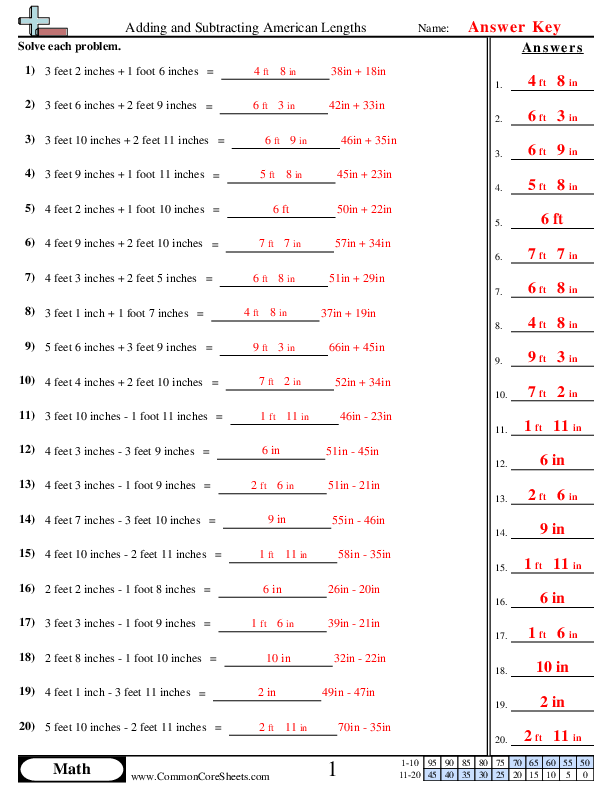
Adding and Subtracting American Lengths


×
Description:
"This worksheet is designed to enhance math skills through the practical application of adding and subtracting American lengths. Consisting of 20 problems, children can engage in converting feet and inches, practicing essential arithmetic operations. Ideal for distance learning, the worksheet is seamlessly transformable into customizable flash cards for varied forms of study and reinforcement of concepts."

×
Student Goals:
Understanding of Length MeasurementsAfter completing the worksheet, students should have gained a strong understanding of how American length measurements are used and how to add and subtract them. They will become proficient in conversions between feet and inches and be able to perform operations involving these two units of measurement without difficulty. This foundational understanding of units of length is a crucial aspect of mathematical education, particularly in real-world problem solving.Problem Solving and Arithmetic FluencyThrough the completion of the worksheet, students will have practiced and enhanced their arithmetic skills, and be able to quickly add up the lengths in feet and inches. They will be able to implement these skills to solve more complex problems as their math education progress. Problem-solving is a critical skill that impacts multiple areas of academic and personal life. Strengthening these skills through such practice helps students to approach complex situations logically and efficiently.Improvement of Mathematical VocabularyThe worksheet helps students to get familiar with key terms related to measurement such as feet and inches. They will be able to accurately use these terms in appropriate contexts, which is essential for further learning in math. Through this understanding of mathematical language, students can communicate their mathematical thinking more effectively in written and spoken form.Application of Knowledge to Practical ScenariosThis worksheet provides a fundamental understanding of measurements, which students can apply not just in future math problems, but also in real-life situations. Whether it's measuring for a DIY project or estimating distances, having a clear understanding of American length measurements can be a useful practical skill for students to possess. These practical applications can motivate students to value the mathematics they learn in the classroom and the importance of such skills in everyday life.Enhancement of Cognitive SkillsFinally, working on such worksheets helps develop skills beyond raw mathematical ability. Problem-solving exercises in math cultivate critical thinking, analytical thinking, and logical reasoning abilities. This hones cognitive skills that are not just essential for academics, but for other aspects of life as well. The process of solving each problem increases students' ability to think critically and improve their analysis, decision making and logical reasoning abilities.



Converting Mixed American Lengths


×
Description:
"This worksheet is designed to engage children in converting American lengths, enhancing their knowledge in practical math. Covering 12 problems with varying levels, it guides students to convert between yards, feet, and inches. Ideal for distance learning, the sheet can be customized to meet individual learning styles, and even converted to flash cards for interactive education."

×
Student Goals:
Enhanced Practical Problem-Solving AbilitiesAfter completing the worksheet, students should be able to effectively solve real-world problems involving the conversion of various American length units. They should be able to apply the learned conversion techniques to different mathematical problems in a pragmatic manner.Solid Understanding of American Length UnitsStudents should also have a comprehensive understanding of American length units, including feet, inches, and yards. They should recognize the relationships between these units and how they can be interchangeably used to measure various objects or distances.Increased Mathematical Fluency and PrecisionOne linkage that would be honed after completing this worksheet is fluency and precision in mathematics. The ability to perform unit conversion swiftly and accurately not only promotes computational fluency but also encourages attention to precision.Advanced Decoding and Comprehension SkillsThe worksheet aids in advancing decoding and comprehension skills. The practice problems are structured such that students need to decode the problem's elements and then comprehend the task. By identifying conversion units and computing arithmetic calculations accurately, students reinforce key comprehension skills.Improved Process SkillsThe worksheet is designed to enhance the students' mathematical process skills. This involves recognizing the problem, converting the unit as per the requirement, solving the problem, and reflecting on the solution. Students should be able to develop these steps naturally and systematically over time.Exposure to Mixed Measurement ConversionsThe mixed nature of the problems offered in the worksheet will expose students to a wide range of measurement conversion scenarios. Thus, students should be skilled at converting from one unit to another, whether it is from feet to inches, yards to feet, or any combination of the three.Increased Confidence and Interest in MathematicsFinally, successfully completing this worksheet will boost students' confidence in their math skills, specifically their ability to convert units of measurement. This increased confidence may also spark a greater interest in mathematics more broadly, potentially inspiring students to explore other complex mathematical concepts with renewed curiosity and persistence.


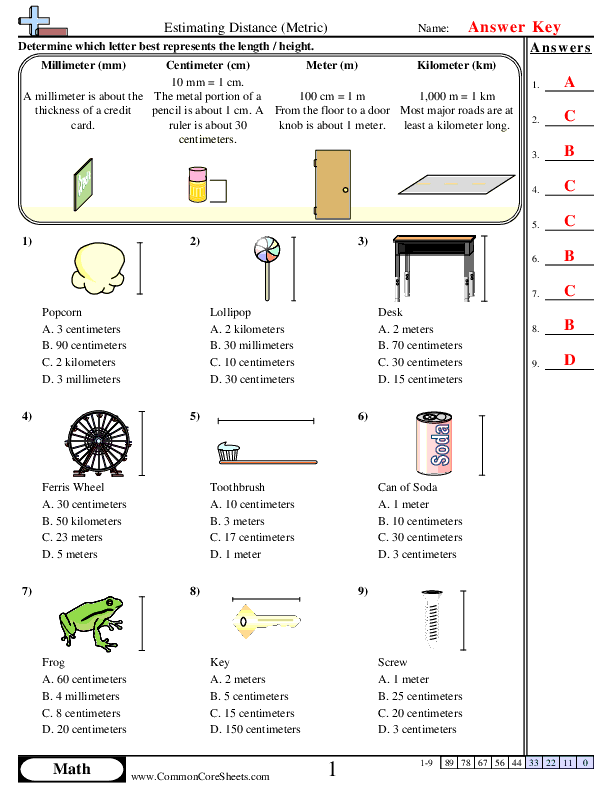
Estimating Length (Metric)
4md1


×
Description:
"This worksheet is designed to enhance children's mathematical skill in estimating distances using the metric system. Comprising nine problem sets, it employs everyday items, from shovels to envelopes, to facilitate comprehension. Perfect for distance learning, these problems can be converted into customizable flashcards for effective learning and easy recall."

×
Student Goals:
Understand Distance MeasurementAfter successfully completing this worksheet, students should attain a comprehensive mastery of distance measurements in metric units. They should be able to recognize and differentiate between millimeters, centimeters, meters, and kilometers, understanding how they relate to each other and how they are used to represent lengths and distances in the real world.Estimating TechniquesFurthermore, students will develop the skill to make accurate estimations. They will be able to gauge the distances of various everyday items without employing measuring instruments, based on their understanding of the comparative lengths of different metric units. Hence, they will understand the application of these units in day-to-day scenarios.Critical Thinking and Problem SolvingWith the knowledge obtained from the worksheet, students should be equipped with better problem-solving and critical thinking abilities. They will be capable of making smart choices from provided options in estimating the length or distance of things. This will be especially useful in instances where precision measuring tools are not readily accessible.Application to Real-life ContextsFinally, students should be able to apply the skills learned in practical real-world contexts. They will understand that the same methods used in estimating the length of a glue stick, or the distance covered in a trip, can be used to solve more complex mathematical problems.Relevance in Other Subject AreasThis knowledge will be useful in overcoming challenges not only in Math but also in other subjects that require measurements such as Science and Geography. For instance, having a good grasp of distances could aid in the study of habitats or geographical features.Build ConfidenceCompletion of the worksheet can build confidence in students, as they would be able to see that mathematics and measurements are concepts that they can grasp and use in their everyday lives. This could lead to a deeper interest in math and other related subjects, encouraging them to explore these further.


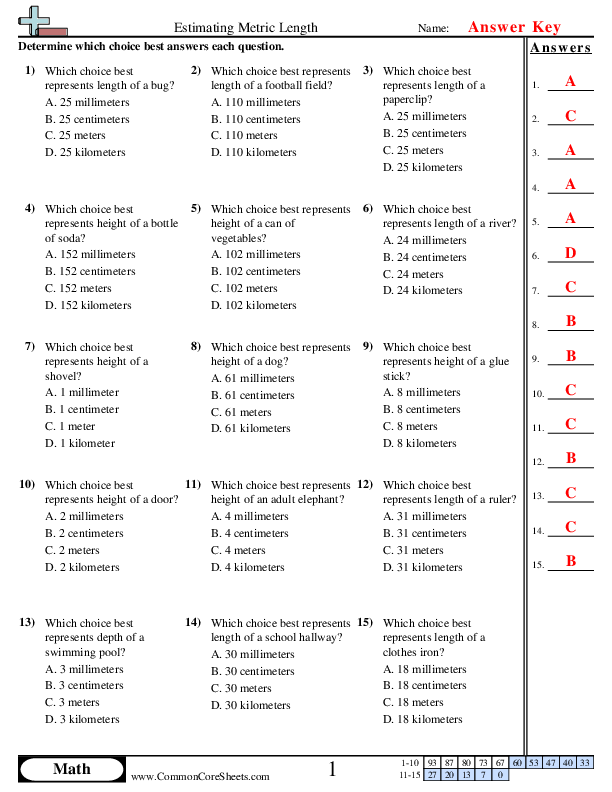
Determining Appropriate Measurement (Metric)
4md1


×
Description:
"This worksheet is designed to help children practice estimation of metric lengths. It offers 15 mathematical problems dealing with real-world objects, varying from daily household items to larger landscapes, to improve the grasp of metric units. This versatile aid can be customized based on a learner's level, transformed into flashcards for revision, or incorporated into distance learning curriculums to effectively and engagingly teach metric length estimation."

×
Student Goals:
Understanding of Metric UnitsAfter completing the worksheet, students should have gained a clear understanding of various metric units of length such as millimeters, centimeters, meters, and kilometers. They will also comprehend how these units relate to real-world objects, enhancing their understanding of metric scales.Problem Solving SkillsThe worksheet aims to enhance critical thinking and problem-solving skills in a student. As they navigate through the problems, they are encouraged to make logical decisions on what metric units best represent the given objects—thus, equipping them with fundamental problem-solving abilities.Practical Application of Math ConceptsPost worksheet completion, students should be able to apply the mathematical concepts learned in practical scenarios. They will be equipped to estimate and measure lengths of various objects around them accurately using the correct metric units.Conceptual KnowledgeStudents will also assimilate conceptual knowledge about the size and scale of everyday items, which will be beneficial not only in their mathematical journey but also in general cognitive development. They will understand the typical length of objects, their comparison, and get a sense of spatial awareness.Improved Estimation SkillsThe worksheet is designed to help students significantly improve their estimation skills. By solving problems that involve estimating the length of various items, students will develop a better sense of judgment. They will learn to make accurate estimates, a skill that is essential in many areas of life beyond math.Strengthens Logical ReasoningUpon completion, students should exhibit improved mental agility and logical reasoning. Probing the metric length of everyday objects and comparing choices demands regular practice for cognitive development, which in turn strengthens their logical reasoning skills.Confidence in Handling MeasurementsStudents will attain familiarity and confidence in dealing with measurements in their day-to-day encounter. By linking realistic objects to measurements, theoretical concepts of metrics and measurements become more approachable and less abstract.


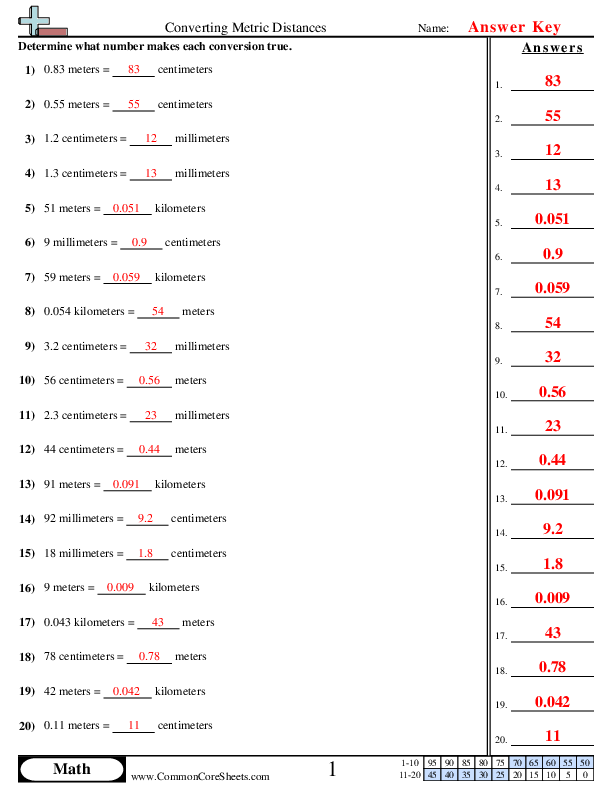
Converting Metric Distances


×
Description:
"This worksheet is designed to support children's understanding of metric conversions in mathematics. Featuring 20 varied problems, it explores concepts such as changing meters to centimeters, millimeters to centimeters, and kilometers to meters. The engaging and dynamic format allows for customization, transformation into flash cards, and is ideal for distance learning environments to amplify children's grasping of metric distance conversions."

×
Student Goals:
Understanding Metric UnitsBy completing this worksheet, students will have developed a strong understanding of standard metric units of distance, including millimeters, centimeters, meters, and kilometers. They will know and understand the relationship between these metric units and be able to convert distances between them effortlessly. This understanding is fundamental in both math and science.Enhanced Problem-Solving SkillsThis worksheet aims at enhancing problem-solving skills. By figuring out conversions between different metric measurements, students will learn to approach math problems logically and systematically. Mastering these skills will not only make them proficient in the math subject but also apply logic in different real-life situations.Accuracy and PrecisionThe completion of this worksheet assures that students can accurately and precisely perform metric conversions. An important mathematic skill, precision plays a significant role in measurements. The skill will also help them to be more meticulous and attentive to details in real-world situations where measurements are required.Improved Math FluencyPost completion of the worksheet, students should demonstrate improved math fluency. They should be able to perform quick calculations and metric conversions without heavily depending on calculators. This will increase their confidence in dealing with numbers, thereby improving their overall mathematical competence.Real World ApplicationBy understanding metric conversion, students will be able to apply these concepts in real-world. Whether they are shopping, cooking, calculating distances, or dealing with scientific measurements, the knowledge and skills they gain from this worksheet will be highly beneficial in numerous practical scenarios.Reinforcement of Core Mathematical SkillsThe worksheet serves to reinforce important mathematical skills. As they focus on the calculation aspect of metric conversion, they concurrently enforce their basic arithmetic skills such as multiplication and division. This overlapping of skills helps define relationships between different mathematical areas and contributes to their overall core mathematical knowledge.



Adding and Subtracting Metric Lengths


×
Description:
"This worksheet is designed to help children master the concept of adding and subtracting metric lengths. It contains 20 problems, each illustrating the applications of math to measurement. The flexible nature allows it to be customized to individual learning needs, converted into flashcards for beneficial repetition, or utilized in a contemporary distance learning setting. A crucial tool for understanding metric system in a fun and engaging manner."

×
Student Goals:
Understanding Metric LengthsAfter completing the worksheet, students should have a firm grasp of metric lengths and their application in simple mathematical problems. They are expected to be efficient in the conversion of measures such as cm to mm, which is crucial in understanding real-world applications related to measurement.Mastering Addition and SubtractionConcentration on addition and subtraction within the worksheet will enable students to improve their aptitude in these fundamental mathematical operations. They can fluently add and subtract different metric lengths, making them proficient in dealing with questions that require these skills.Developing Problem-solving skills and Mathematical ReasoningThe worksheet provides a hands-on experience in solving problems related to adding and subtracting metric lengths, offering a fun way to develop their problem-solving skills. Through these problems, students enhance their mathematical reasoning abilities as they familiarize themselves with the concepts underlying these operations.Improving Mental Math SkillsAs students practice and solve the problems in the worksheet, they will inherently improve their mental math skills. The process of adding or subtracting metric lengths promotes quick thinking and mental computation, skills that are important in their overall intellectual development.Enhancing Accuracy and SpeedThe multitude of problems presented in the worksheet gives students ample practice, which is key to boosting their accuracy and speeding up their mathematical computations. They should be able to work out similar problems in the future with minimal errors and in a shorter amount of time.Applying Knowledge in Real-world ContextsUpon completion of the worksheet, students should be able to apply their learning in real-world contexts. Understanding how to add and subtract metric lengths is more than just a classroom exercise. It is a valuable life skill, useful in scenarios like calculating distances, measuring lengths in science experiments, and more.


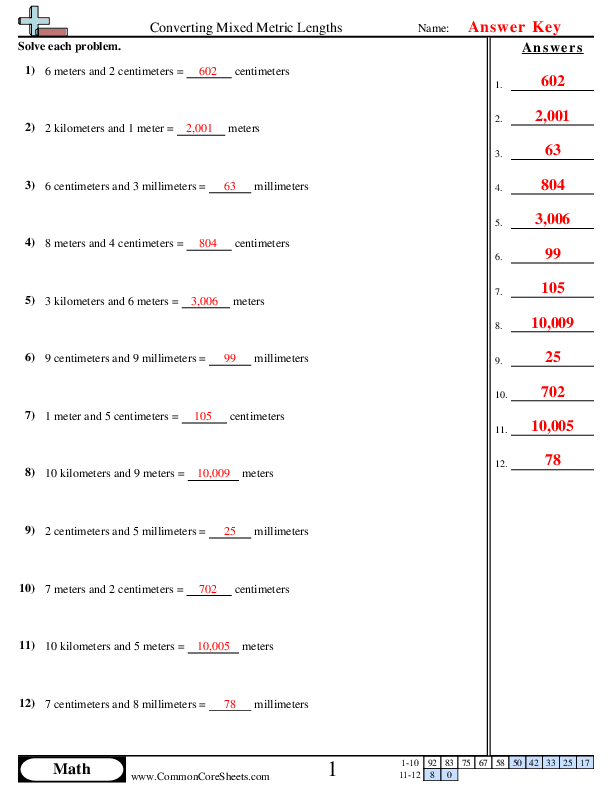
Converting Mixed Metric Lengths


×
Description:
"This worksheet is designed to enhance children's mathematical abilities in converting mixed metric lengths. It contains 12 instructive problems that require kids to convert measurements like kilometers, meters, centimeters, and millimeters. Ideal for distance learning, this versatile worksheet can also be customized or transformed into flashcards for a more interactive learning experience."

×
Student Goals:
Understanding of the Metric SystemUpon completion of this worksheet, students should have gained a better understanding of the metric system. They would have exercised their ability to convert lengths in the metric system, which includes being able to accurately convert kilometers to meters, meters to centimeters, and centimeters to millimeters, and vice versa. This not only enhances their fluency in maths but also equips them with practical skills for solving real-life problems that involve measurements.Problem Solving SkillsAs students navigate through the depicted math problems, they would reinforce their problem-solving skills. The worksheet encourages students to apply their knowledge while finding solutions, which helps them to attain a higher cognitive level. By finding solutions to the conversion of mixed metric lengths, they would also understand how to apply their knowledge in different scenarios, and generalize their learning into various contexts.Precision and AccuracyAfter completing this worksheet, the students should have developed an understanding of the precision and accuracy in mathematics. Whether counting, adding, measuring, or comparing values, an appreciation for the preciseness and accuracy required in retrieving measurements and quantitative information is developed. This precision not only applies to the mathematical world but also plays a significant role in scientific investigations and daily life.Development of Quantitative SkillsThis worksheet helps students to boost their mathematical skills specifically dealing with numbers and figures. The students would be more comfortable dealing with large numbers, and different units of measurement, converting between them swiftly and accurately. The skill set can be beneficial in various scenarios, from calculating distances to understanding quantitative data in academic research.Confidence with MeasurementsHandling numbers and units should become more familiar to students after completing the worksheet. As they grow a better understanding of the metric system and how its components relate, they should become more comfortable and confident using these measurements. This fluency is vital across many academic subjects and will play a significant role in future studies.


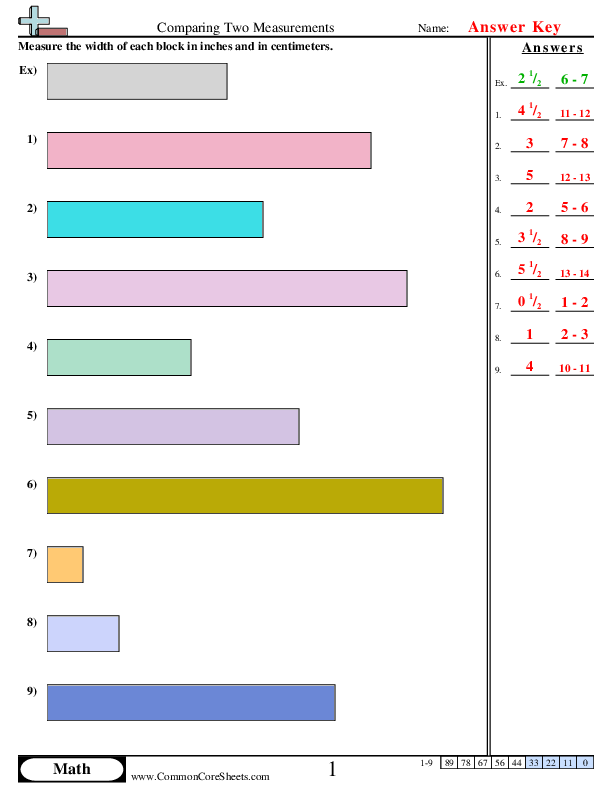
Comparing objects width
2md4


×
Description:
"This worksheet is designed to enhance children's math skills, focusing on comparing two measurements. It offers a challenging series of 9 problems that instill the concepts of measurement comparison. With the versatility of customization, it also allows practitioners to convert it into flashcards or integrate it into distance learning modules, promoting enjoyable math learning experiences from any location."

×
Student Goals:
Measurement UnderstandingUpon completion of the Comparing Two Measurements worksheet, students should be able to gain a robust understanding of measurements. They should be capable of distinguishing between different types of measurements, appreciating their differences, and need in real-life situations.Comparison SkillsThis problem set is designed to enhance students' comparison skills, particularly when dealing with numerical data associated with measurements. Post-completion, students will be skilled at judging which measurement is larger or smaller, thus providing them an essential skill required for mathematics and daily life.Critical thinkingOne of the paramount accomplishments of students will be the ability to develop and apply critical thinking abilities. The students will be trained to interpret and solve problems from various angles. It aims to boost their cognitive abilities and allow them to think more in-depth about the problems they are working on.Application of Mathematical ConceptsBy solving this worksheet, students will get to apply the mathematical concepts learned in class to practical problems. They would understand and learn the practical applicability of mathematical concepts and principles, thereby enhancing their ability to relate classroom theory to practical real-world scenarios.Problem-Solving skillsCompleting the worksheet will also improve the students' problem-solving skills. These skills involve not only understanding and planning how to approach a problem but also executing the plan and rechecking the solution. This practice can build their confidence and improve their performance in math tests and exams.Competence and Confidence BuildingPost-completion, students would witness a noticeable increase in their mathematical competence and overall confidence. By successfully tackling and solving unforeseen challenges and complex measurement problems, they will build tenacity and resilience, an attribute that is invaluable in every sphere of their academic and personal life.


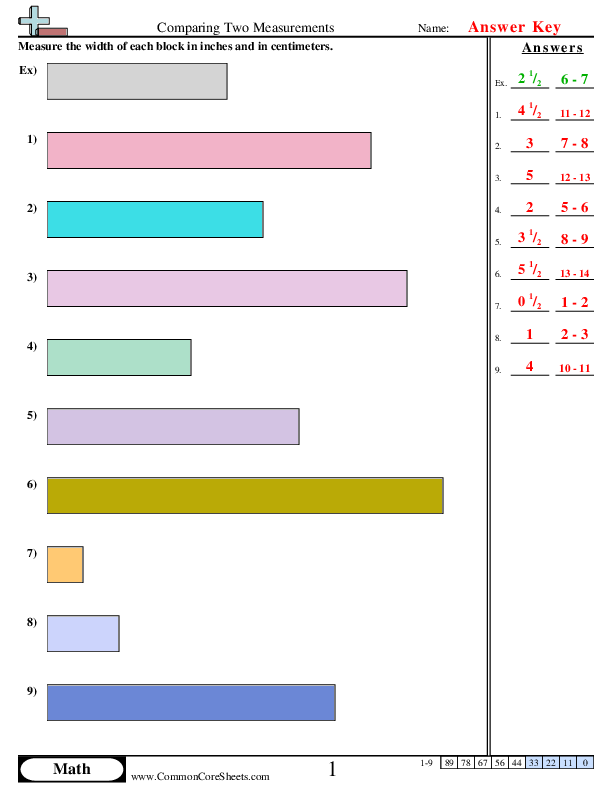
Comparing Two Measurements (Width)
2md2


×
Description:
"This worksheet is designed to strengthen children's math skills by comparing two measurements. Featuring nine diverse problems, it encourages critical thinking and promotes math engagement. Highly customizable, it can be converted into interactive flash cards or utilized in distance-learning settings, making it equally suitable for classroom or home-based learning. A fantastic tool for young learners ready to explore complex concepts in a fun, accessible format."

×
Student Goals:
Understanding of MeasurementsBy completing this worksheet, students should enhance their understanding of measurements. They will gain a hands-on knowledge about the different units of measurements used in math and broaden their comprehension of key mathematical concepts related to measurements.Comparison SkillsStudents will have the opportunity to improve their comparison skills. They will learn to analyze and compare different measurements, identify patterns, and establish relationships between them. These skills are fundamental in developing mathematical and logical thinking.Problem-solving abilitiesThrough the nine problems provided in the worksheet, students can improve their problem-solving abilities, learning to apply comparison tools to evaluate and solve math problems. It aids in the development of their critical thinking skills, necessary to understand complex math problems in the future.Practical Application of Math ConceptsAfter completing the worksheet, students should be able to apply the math concepts in real-life scenarios effectively. They will realize the importance of measurements and comparisons in their daily lives, such as comparing lengths, weights or time. This will also bring significance to their learning process making math relevant.Increase Precision and AccuracyWorking on these problems will enable students to enhance their accuracy and precision. They need to pay meticulous attention to detail to arrive at the right solution which ultimately sharpens their focus, accuracy, and overall performance in mathematics.Boost ConfidenceSuccessfully understanding and completing the problems on the worksheet will boost the student's confidence in their mathematical abilities. This sense of achievement can motivate them to tackle more complex math problems and overall enhance their interest in the subject.


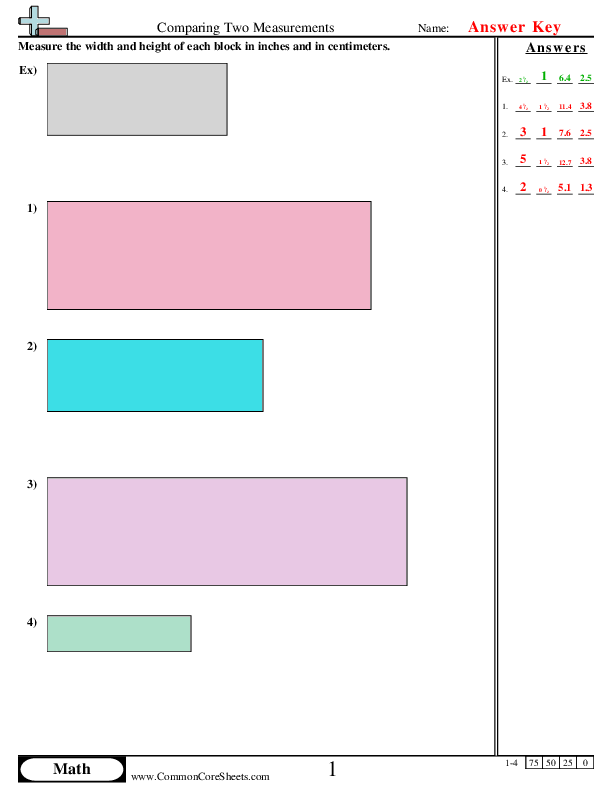
Comparing Two Measurements (Width & Height)
2md2


×
Description:
"This worksheet is designed to enhance children's mathematical understanding by comparing two measurements. It includes four engaging problems that foster analytical skills in kids. The worksheet promotes versatility: it can be easily customized to fit individual learning needs, converted into flashcards for interactive learning, or used effectively in distance learning environments. This utility ensures it's a beneficial resource supporting progressive math education for children."

×
Student Goals:
Develop Mathematical SkillsAfter completing this worksheet, students should have enhanced their math skills, particularly in comparing two measurements. They would have been given a hands-on opportunity to tackle problems that require comparison of different measures, challenging their critical thinking and decision-making abilities.Boost Problem-Solving AbilitiesThese math problems aim to expand children's problem-solving abilities. By strategically analyzing the problems presented on the worksheet, students would develop their ability to examine, break down, and solve complex maths problems, a skill that extends beyond the classroom and is valuable in daily life.Enhance Interpretation SkillsBy engaging with this worksheet, students will fine-tune their interpretation skills. Comparing two measurements involves interpreting and understanding each measurement first before a comparison can be made. This could improve their overall narrative comprehension abilities and even enhance their aptitude in the sciences and other related subjects.Familiarity with Different Units of MeasurementArising from the completion of the worksheet, students should be more comfortable with different units of measurement. This bolsters their flexibility in dealing with different measurement units, making it easier for them to grasp more intricate measurement-related concepts in higher levels of mathematics.Promote Logical ReasoningThrough these problems, kids would have practiced and improved logical reasoning. The exercise of comparing measurements stretches the student's ability to reason logically, which is critical not only in mathematics but in many facets of learning and everyday decision-making.Increase Confidence in Math AbilityAs the students work through each problem with increasing familiarity and skills, they would build their confidence in handling math problems. This confidence boost can lead to better performance in upcoming math tasks and assessments, fostering a genuine interest and steady progress in their mathematical journey.



Word Measurement Estimating
2md3


×
Description:
"This worksheet is designed to improve children's math skills, specifically in measurement estimation. Through 20 varied problems, the children are challenged to estimate the dimensions of common objects like a textbook, soup can, or football field. Adaptable to a child's individual needs, the worksheet can be customized, converted into flash cards, or used for distance learning activities, making it a versatile resource for enhancing their understanding of measurements in an engaging and tangible way."

×
Student Goals:
EstimationStudents will develop their estimation skills, crucial in everyday mathematics and problem-solving. They will learn to make reasonable guesses about an object's dimensions without actual measurement, building their sense of spatial awareness and magnitude.Appreciation of Units of MeasurementUpon completion of the worksheet, students will have a refined understanding of different units of measurement. They will comprehend the relevance of different measurement units like centimeters, inches, meters, or feet and their application to real-world objects. This sectional work can construct foundational knowledge required for learning more advanced measurement concepts.Application of Mathematical KnowledgeStudents will gain the ability to apply their mathematical knowledge to everyday objects, linking theoretical math concepts with real-world applications. This can aid in fostering a significant comprehension of math, viewing it as a practical and useful subject rather than abstract theory.Comparison AbilitiesThe worksheet will enable students to develop their comparison abilities. By understanding the relative lengths and heights of various objects, they can conceptualize the comparative sizes of different objects, leading to better spatial-reasoning skills.Critical ThinkingCompleting the measurement estimating worksheet can help students hone their critical thinking skills. They will have to rely on both their math knowledge and logical thinking to determine the most reasonable unit to measure different items.Development of Cognitive SkillsDrawing estimates encourages children to observe closely and attentively, fostering sharpens observation, visualization, and mental agility. This activity will serve to stimulate their cognitive development, enhancing mental calculation, decision-making ability, and improving concentration.


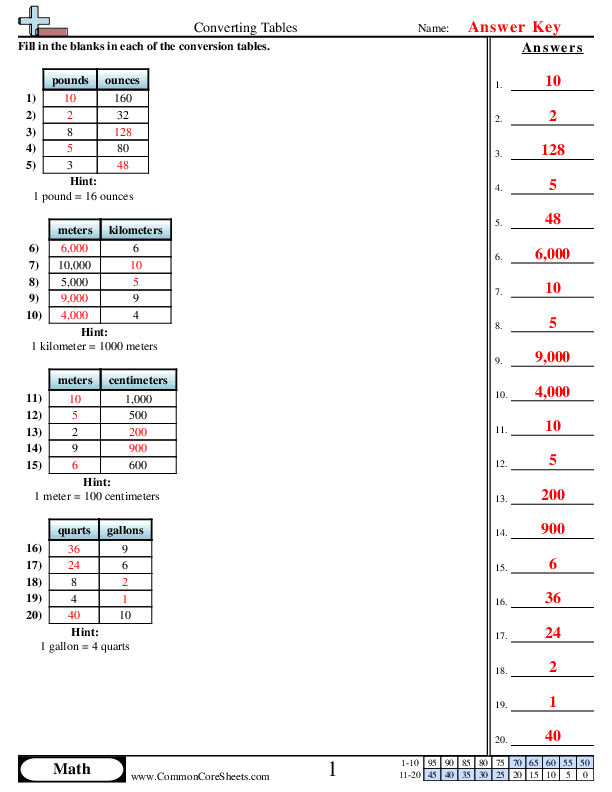
Conversion Tables
4md1


×
Description:
"This worksheet is designed to enhance children's math skills, focusing on the method of converting tables. Comprising 20 problems ranging from base to complex numbers, it reinforces the fundamentals of number conversion. Each problem can be customized, transformed into flashcards for hands-on learning or incorporated into distance education modules. A brilliant tool to make learning fun and effective!"

×
Student Goals:
Enhance Mathematical SkillsUpon completion of the 'Converting Tables' worksheet, students should have significantly improved their mathematical skills. Complex concepts are simplified into understandable chunks, allowing young learners to grasp them easily. This foundational comprehension can make subsequent topics easier to understand.Improve Problem-Solving AbilitiesThis math worksheet is designed to enhance problem-solving abilities in children. The various problems provided prompt students to apply conventionally learned strategies in order to find solutions, developing their ability to think critically and independently.Develop Analytical SkillsUsing this worksheet, students should be able to cultivate their analytical skills. They learn how to examine a problem, analyze the information provided, plan a solving strategy, and critically review their results. This development is crucial not only in tackling math problems but also in everyday scenarios.Boost Confidence & ResilienceThe process of tackling and successfully finishing the worksheet tasks can boost a student's confidence in their own abilities. Additionally, they learn that it is okay to make mistakes, as they are a part of learning—a concept that builds resilience.Enhance Cognitive SkillsChildren's cognitive skills are improved as they manipulate numbers, apply formulas, and uncover patterns through these worksheets. They will not only understand the 'how' but also the 'why' behind solving these questions, which promotes higher-level thinking.Promote the Love for NumbersThis worksheet paves the way for students to develop a lifelong love and appreciation for numbers. By gradually solving these problems and understanding core concepts, maths becomes less intimidating and more appealing.Prepare for Advanced TopicsThe completion of this worksheet implies the foundation necessary for more advanced mathematical concepts has been set. It prepares the students for future topics, both in terms of concepts and the confidence to tackle difficult problems.


Balancing Mixed Measurements


×
Description:
"This worksheet is designed to enhance children's math skills by focusing on balancing mixed measurements. It features 20 problem sets involving liter-milliliter, year-month, gallon-quart, milliliter-liter, meter-kilometer, minute-hour, foot-inch, day-hour, day-week, and month-year conversions. This flexible learning tool comes with customization options, is convertible into flash cards, and supports distance learning, catering to diverse learning styles and methods."

×
Student Goals:


